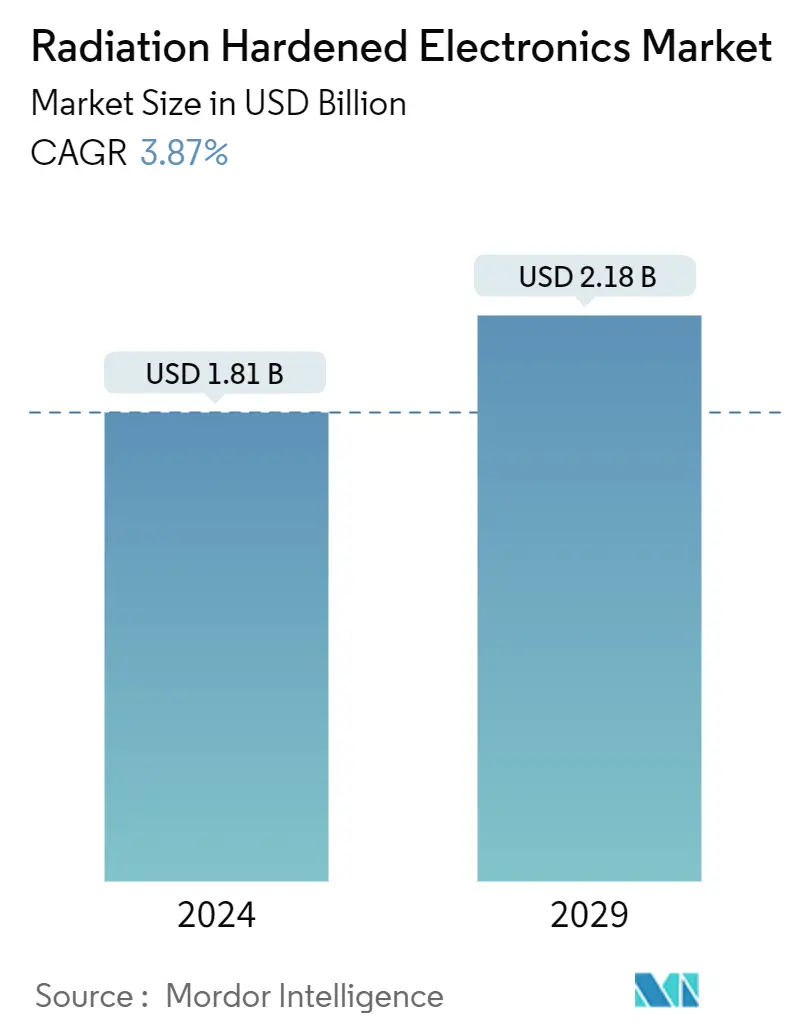Market Size of Radiation Hardened Electronics Industry

| Study Period | 2019 - 2029 |
| Market Size (2024) | USD 1.81 Billion |
| Market Size (2029) | USD 2.18 Billion |
| CAGR (2024 - 2029) | 3.87 % |
| Fastest Growing Market | Asia Pacific |
| Largest Market | Americas |
| Market Concentration | Low |
Major Players
*Disclaimer: Major Players sorted in no particular order |
Radiation-Hardened Electronics Market Analysis
The Radiation Hardened Electronics Market size is estimated at USD 1.81 billion in 2024, and is expected to reach USD 2.18 billion by 2029, growing at a CAGR of 3.87% during the forecast period (2024-2029).
- Radiation-hardened electronics, designed to withstand extreme radiation exposures, are integral to Intelligence, Surveillance, and Reconnaissance (ISR) systems. The increased demand for security measures like monitoring, information collection, and border control is driving the need for these specialized electronics. In high radiation environments, proper power management is crucial for radiation-hardened materials, as any electronic damage can pose safety hazards. Thus, reliable radiation-hardened power management systems are essential in such facilities.
- The space industry extensively employs radiation-hardened electronics, contributing significantly to the market's growth. For example, in 2022, the global space economy generated USD 384 billion in revenue, according to the Satellite Industry Association. Additionally, as of 2022, approximately 7,316 active satellites were orbiting the Earth, marking a 51% increase from the previous year and a 321% increase over the past five years.
- Satellites in orbit face substantial exposure to highly energetic charged particles and electromagnetic radiation unique to the space environment. The radiation levels they encounter depend on their distance from Earth; satellites in low earth orbit, situated within the thermosphere, are more exposed to UV radiation, potentially impacting the molecular composition of electronic materials.
- Inside nuclear power plants, electrical and electronic systems are subjected to high-energy radiation that can severely affect their functionality and overall safety. Ionizing radiation within these plants creates electron-hole pairs, altering transistor parameters and potentially causing their destruction.
- Additionally, this radiation can induce leakage currents between circuits. Therefore, installing radiation-hardened electrical/electronic systems with proper shielding is critical for system designers, a key factor driving market growth.
- Despite increasing demand for radiation-hardened electronic components across various industries, the market faces challenges due to higher design and development costs. Specific design considerations are necessary to create electronics that can withstand harsh operating conditions, contributing to increased development costs. Furthermore, stringent testing is essential to ensure product reliability, further elevating the cost of radiation-hardened electronics.
Radiation-Hardened Electronics Industry Segmentation
Radiation hardening is a technique to design and manufacture electronics for use in high-altitude or hazardous applications where the fielded equipment is susceptible to damage and malfunctions caused by gamma and neutron radiation. The radiation-hardened electronics market comprises sophisticated radiation-hardened electronics systems used for various space, military, and commercial applications, such as satellite system power supply, switching regulators, microprocessors in the military, and control systems in nuclear reactors.
The radiation-hardened electronics market is segmented by end-user (space, aerospace and defense, and nuclear power plants), component (discrete, sensor, integrated circuit, memory, and microcontrollers and microprocessors), geography (Americas, Europe, Asia Pacific, and Rest of the World). The report offers the market size and forecasts in value (USD) for all the above segments.
| By End-user | |
| Space | |
| Aerospace and Defense | |
| Nuclear Power Plants |
| By Component | |
| Discrete | |
| Sensors | |
| Integrated Circuit | |
| Microcontrollers and Microprocessors | |
| Memory |
| By Geography*** | |
| Americas | |
| Europe | |
| Asia | |
| Australia and New Zealand | |
| Latin America | |
| Middle East and Africa |
Radiation Hardened Electronics Market Size Summary
The radiation-hardened electronics market is poised for steady growth, driven by the increasing demand for specialized electronics capable of withstanding extreme radiation environments. These components are crucial for applications in Intelligence, Surveillance, and Reconnaissance (ISR) systems, as well as in the space and nuclear power industries. The need for robust power management systems in high-radiation areas underscores the importance of these technologies. The space sector, with its growing number of satellites and missions, significantly contributes to market expansion. Similarly, the nuclear power industry relies on radiation-hardened electronics to ensure the safety and efficiency of reactor operations, particularly in high-radiation environments. Despite the rising demand, the market faces challenges due to the high costs associated with the design, development, and testing of these specialized components.
In the Asia Pacific region, the market is experiencing notable growth, fueled by China's advancements in aerospace and semiconductor technologies. The country's focus on indigenizing its military and defense sectors through the development of radiation-hardened chips and systems is a key driver. This strategic emphasis on microelectronics and security is further supported by the flourishing semiconductor industry in the region. Major players in the market, such as Honeywell International Inc., BAE Systems PLC, and Texas Instruments, are actively engaging in partnerships and acquisitions to enhance their product offerings and maintain a competitive edge. These collaborations aim to provide integrated solutions for aerospace and defense applications, while also addressing the growing need for reliable and efficient radiation-hardened electronics across various industries.
Radiation Hardened Electronics Market Size - Table of Contents
-
1. MARKET INSIGHTS
-
1.1 Market Overview
-
1.2 Industry Attractiveness - Porter's Five Forces Analysis
-
1.2.1 Bargaining Power of Suppliers
-
1.2.2 Bargaining Power of Buyers
-
1.2.3 Threat of New Entrants
-
1.2.4 Threat of Substitute Products
-
1.2.5 Degree of Competition
-
-
1.3 Raw Material Analysis for Radiation-Hardened Components
-
-
2. MARKET SEGMENTATION
-
2.1 By End-user
-
2.1.1 Space
-
2.1.2 Aerospace and Defense
-
2.1.3 Nuclear Power Plants
-
-
2.2 By Component
-
2.2.1 Discrete
-
2.2.2 Sensors
-
2.2.3 Integrated Circuit
-
2.2.4 Microcontrollers and Microprocessors
-
2.2.5 Memory
-
-
2.3 By Geography***
-
2.3.1 Americas
-
2.3.2 Europe
-
2.3.3 Asia
-
2.3.4 Australia and New Zealand
-
2.3.5 Latin America
-
2.3.6 Middle East and Africa
-
-
Radiation Hardened Electronics Market Size FAQs
How big is the Radiation Hardened Electronics Market?
The Radiation Hardened Electronics Market size is expected to reach USD 1.81 billion in 2024 and grow at a CAGR of 3.87% to reach USD 2.18 billion by 2029.
What is the current Radiation Hardened Electronics Market size?
In 2024, the Radiation Hardened Electronics Market size is expected to reach USD 1.81 billion.

